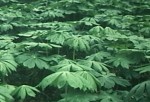
Wet soil can be a problem in any garden and finding plants with handsome foliage that will grow there in full sun can be even more difficult. There are, however, some striking native plants that love boggy or swampy condition and add a special aura to a wet area. Some even have colorful flowers to add to the display.
Here are five native plants of medium height that are suitable for moist to wet gardens in sun.
 Marsh Marigold (Caltha palustris)
Marsh Marigold (Caltha palustris)
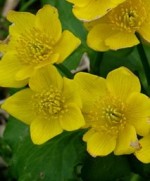 Plants grow into large clumps with rounded, slightly heart-shaped shiny leaves with toothed margins. Golden yellow flowers 1½” across open as the plant emerges in spring. Plants bloom for 3-4 weeks and go dormant by midsummer.
Plants grow into large clumps with rounded, slightly heart-shaped shiny leaves with toothed margins. Golden yellow flowers 1½” across open as the plant emerges in spring. Plants bloom for 3-4 weeks and go dormant by midsummer.
Size:
- 1-2’ H x 1’ W
Native Range:
- Swamps, shallow marshes, wet meadows and stream sides from Newfoundland to Manitoba, south to North Dakota, Illinois, and North Carolina; the Northwest Territories and Alaska south to British Columbia
Bloom Color:
- Golden yellow
Bloom Time:
- Early spring
Light:
- Sun to shade
Hardiness:
- Zones 2-8
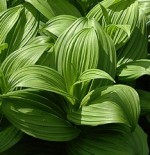
 False Hellebore (Veratrum viride)
False Hellebore (Veratrum viride)
A toxic plant with some known for some medicinal benefits, false hellebore is not to be used for experimentation. It has no relation to the genus Helleborus, an attractive garden plants with the common name hellebore. The large light green leaves are pleated and spiral away from a thick stem. The appear in the spring and go dormant in early summer.
Size:
- 2-6’ H x 2’ W
Native Habitat:
- Wet woods and swamps from Canada to the Carolinas but is also found in Alaska, and the mountains of Idaho, Oregon, and Washington
Bloom Color:
- Greenish yellow
Bloom Time:
- Early spring to summer
Light:
- Sun to part shade
Hardiness:
- Zones 3-8
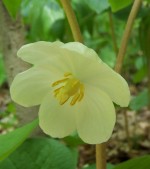
 Mayapple (Podophyllum peltatum)
Mayapple (Podophyllum peltatum)
Two large, flat, broad leaves form a heavy umbrella over the small creamy white flower that is borne beneath them in early spring. Plants form large colonies by means of rhizomes that lie near the surface of the soil. In cool areas, leaves persist all season but in hot dry areas plants go dormant in mid to late summer.
Size:
- 8-18” H x 4-6’ W
Native Range:
- Moist woods, streambanks, bottomlands,rich deciduous forests from Quebec and Minnesota, south to Florida and Texas
Bloom Color:
- White
Bloom Time:
- Spring
Light:
- Light to full shade
Hardiness:
- Zones 3-9
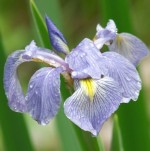
 Southern Blue Flag Iris (Iris virginica)
Southern Blue Flag Iris (Iris virginica)
A vigorous, spreading plant, southern blue flag looks very much like its cousin northern blue flag (Iris versicolor) except that it is shorter and carries its flowers on stems that equal the height of the leaves. In addition, the leaves of southern blue flag iris emerge with a burgundy tinge that persists into summer.
Size:
- 2-3’H x 2’ W
Native Range:
- Marshes, pond edges, wet ditches, low meadows and wetlands along the coast from Maryland to Texas
Bloom Color:
- Light to dark violet
Bloom Time :
- Late spring
Hardiness:
- Zones 5-9
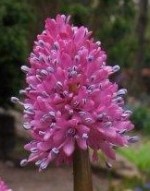
 Swamp Pink (Helonias bullata)
Swamp Pink (Helonias bullata)
This rare plant has a small native range but is a very good garden plant when grown on the side of a pond or in a bog garden. The evergreen strap-shaped leaves form a rosette that produces a fan of leaves and a thick stalk that bears the sweetly fragrant flowers, if you are lucky. Although few swamp pinks are seen in the wild considerable success has bee achieved propagating and distributing them so they can be found in the trade.
Size:
- 10-16” H x 12-18”W
Native Range:
- Swamps and bogs on the coastal plain from New Jersey to South Caroline; Blue Ridge Mountains from Virginia to Georgia
Bloom Color:
- Pink, blue
Bloom Time:
- Spring
Light:
- Sun to light shade
Hardiness:
- Zones 5-9
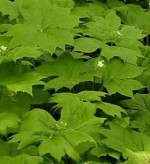
 Umbrella Plant (Diphylleia cymosa)
Umbrella Plant (Diphylleia cymosa)
The coarse leaves of this spectacular plant are 2-3 feet across, lobed and partially divided. In spring to early summer umbels of small white flowers are held above the leaves, make a sharp contrast in size and texture. The plants reach maturity in a 3-4 years and form large impressive clumps.
Size:
- 18-28” H x 24” W
Native Range:
- Moist areas along streams and seeps in the Blue Ridge Mountains from Virginia to Georgia
Bloom Color:
- White
Bloom Time:
- Spring
Light:
- Part sun to shade
Hardiness:
- Zones 4-8
When choosing plants primarily for foliage consider the color and the texture. Striking combinations can be made using large coarse leaves against fine spiky ones. Or place slender upright leaves next to a mound of large leaves. When using plants that go dormant in summer, like false hellebores, plan for some plants that will grow later in the season and fill in the space left by the dormant plant.
